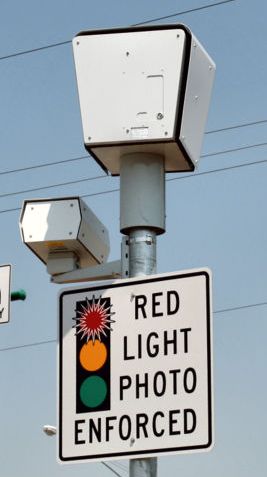 Peoria Police Chief Steven Settingsgaard says he’s not proposing red-light cameras as a way to bring more revenue into the city, but only as a way to improve safety because speeding is one of the most common causes of rear-end collisions.
Peoria Police Chief Steven Settingsgaard says he’s not proposing red-light cameras as a way to bring more revenue into the city, but only as a way to improve safety because speeding is one of the most common causes of rear-end collisions.
“I don’t care about the revenue, not one bit,” Settingsgaard said via e-mail. “It would be a Council decision ultimately but I would like to see any revenue go toward something that also helps traffic safety in the City rather than going into the general fund or to the police department.”
For example, he suggested the revenue could go toward construction or repair of sidewalks, which would improve pedestrian safety. “I believe there a lots of options here that would put the money to good use but would also alleviate any fears that red light cameras are first and foremost revenue generators.”
According to a recent Peoria Times-Observer article, Peoria Mayor Jim Ardis also “told [state] legislators this request was not being sought to create a revenue generator for the city.” Instead, it’s all about safety. “Our community is very dangerous,” he was quoted as saying.
According to the 2009 Crime Summary and additional statistics obtained through a Freedom of Information Act request, only 2.8% of all traffic citations (721 of 25,476) and 3.8% of total accidents (173 of 4,560) were for red-light violations. But Settingsgaard believes these numbers can be deceiving.
“The number of citations or percentage of citations issued do not reflect the severity of the problem,” he explained. “It is the difficulty of enforcing red light running that is a major deterrent to enforcement and contributes to the low number of citations, not the lack of violators.”
For the police to safely and effectively enforce red lights, it takes two officers and two cars. One officer (the “witnessing officer”) is positioned in front of the intersection and is the one who actually observes the violation. The other officer (the “pursuing officer”) is positioned on the other side of the intersection and is the one who pursues the violator. It would be unsafe for the witnessing officer to try to pursue the violator through the intersection.
Given the time and staffing required to stake out traffic signals, Settingsgaard believes it would be cheaper and more effective to use photo enforcement.
While recent studies have shown that red-light cameras actually increased the number of crashes at photo-enforced intersections, those crashes have been rear-end fender-benders. In contrast, red-light runners cause “T-bone” style crashes, Settingsgaard point out, which “are extremely hazardous and injuries can be severe if not fatal.”
“It is important to note though that the need goes beyond the actual number of crashes or even the severity of crashes,” he continued. “Just like perception of crime is nearly as important as crime itself, perception of traffic safety is important. It is a common perception, and maybe a common reality, that it is wise in Peoria to pause before proceeding with a green light due to the prevalence of red light runners. This perception/reality impacts the quality of life in Peoria and it frustrates the public when they believe the police don’t give it enough attention.”
My take: With all due respect to the Chief and the Mayor, I don’t see any warrant for using photo-enforcement. I think it’s clear that all safety concerns are based on nothing more than anecdotal evidence and subjective experience. Thus, if photo-enforcement were established, there would be no objective way to quantify or measure its effectiveness. Any claims of improved safety would be anecdotal as well.
The only thing we would be able to measure is how many citations are being issued and how much money it’s bringing into the city. Despite the Mayor’s and Chief’s professed disinterest in that revenue, I don’t think it’s cynical to recognize the city will inevitably become addicted to the revenue once it starts. So even if the establishment of photo-enforcement is not motivated by desire for a new revenue stream, the end result will be the same. Red-light cameras will be little more than a means to extract more money from residents under the pretense of improving safety.

 Peoria Police Chief Steven Settingsgaard says he’s not proposing red-light cameras as a way to bring more revenue into the city, but only as a way to improve safety because speeding is one of the most common
Peoria Police Chief Steven Settingsgaard says he’s not proposing red-light cameras as a way to bring more revenue into the city, but only as a way to improve safety because speeding is one of the most common  David Kennedy has been getting a lot of attention across the nation with his unorthodox — but successful — methods of lowering violent crime in urban areas. He’s the director of the Center for Crime Prevention and Control at John Jay College of Criminal Justice in New York City. I first heard about Kennedy through the Smart City radio broadcast (
David Kennedy has been getting a lot of attention across the nation with his unorthodox — but successful — methods of lowering violent crime in urban areas. He’s the director of the Center for Crime Prevention and Control at John Jay College of Criminal Justice in New York City. I first heard about Kennedy through the Smart City radio broadcast (